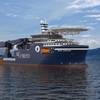According to a study just completed by IMA, 121 floating production systems are in operation or available. This is an increase of approximately 90 percent over the number of units in operation five years ago. About one-quarter of the units are operating off Northern Europe, another quarter off Brazil and the remainder are mostly in the Gulf of Mexico, offshore China/Southeast Asia, West Africa and Australia.
Recent burst of orders for floaters
Reflecting upbeat conditions in the oil and gas sector, there has been a burst of orders for new floating production systems over the past six months. Between September 2000 and March 2001, eight production units have been ordered: four FPSO vessels, three spars and a production semi. With these new orders 27 floating production systems are now being built (see chart 1).
Source: IMA, Floating Production Study
What type floaters are being built?
A noticeable shift has taken place in type production system now being built vs. five years ago. In 1996, about one-quarter of the production units on order utilized semisubmersible hulls. Now spars comprise about one-quarter of the production units on order and only two of the 27 units currently on order are semisubmersibles. Accounting for this shift in platform is the growing popularity of spars as dry completion units and the lack of suitable semisubmersible hulls that can be used for conversion to production facilities.
Where will they be placed?
A noticeable shift has also taken place in where these floating production systems are to be used. Almost half of the units under construction in 1996 were for fields in the North Sea and another 30 percent of the units were destined for use offshore Brazil. Now the major destination is the Gulf of Mexico, which accounts for more than one-third of the systems currently on order. Equally significant is the increased presence of West Africa as a destination for floating production systems. There are now as many systems on order for use off West Africa as for use in the North Sea.
New floaters planned or under study
IMA has identified 155 offshore projects in the bidding, design or planning stage where a floating production and/or storage system is being considered as a development solution. Projects off West Africa account for 26 percent of these planned projects and the Gulf of Mexico accounts for another 22 percent. There has been a significant drop in number of projects planned in the North Sea vs. five years ago, reflecting the downturn in new activity in the North Sea.
Future equipment orders
Over the next five years, we are projecting orders for an average of 13 to 17 production floaters annually. FPSO vessels will clearly be the predominant type f production unit, accounting for more than two-thirds of the units to be constructed. These units have the advantage of large process plant carrying capacity, storage capability, wide availability of secondhand tanker hulls, low prices on new hulls from Asian yards and relatively easy relocation from field to field. Production spars will be the second favored production solution. They are particularly suited to deepwater, mid-sized fields that have access to pipeline infrastructure. A particularly advantage of spars is their ability to accommodate dry trees, a major feature on fields with high paraffin content. TLPs, particularly the mini version, and production semis will make up the remainder of orders.
Orders for shuttle tankers — A number of fields in the ultra-deepwater sector of the Gulf of Mexico are not within the economic reach of the existing pipeline infrastructure and shuttle tankers will be the only option for transporting produced crude to U.S. refineries. These vessels will likely be Aframax size, fitted with dynamic positioning capability and priced in the area of $100 million. We expect the first orders for Gulf of Mexico shuttle tankers to be placed within the next 12 to 24 months, providing an interesting source of business for shipbuilders and equipment suppliers.
This article is an excerpt from IMA series of studies on floating production systems. The full series is available for $1,400. A description of the floating production series, as well as a description of our new report on Gulf of Mexico shuttle tankers, is available on our website at www.imastudies.com.
Featured videos

Tracking Foreign Vessels Working in the U.S. Jones Act Market

Inmarsat Enhances Service to Drive Digitalization

Inside the Electrified Truckable Tug
Subscribe for
Maritime Reporter E-News
Maritime Reporter E-News is the maritime industry's largest circulation and most authoritative ENews Service, delivered to your Email five times per week









